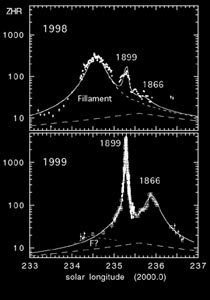|
Leonid MAC |
| home |
| View the shower |
| Mission Brief |
| Science Update |
| Media Brief |
| links |
LEONID DAILY NEWS: November 2, 2000
TWIN SHOWERS When Earth travels the debris field of comet 55P/Tempel-Tuttle come November 16-18, 2000, there will be not one, but two meteor showers visible from the United States, according to new model calculations by Finnish astronomer Esko Lyytinen and his U.S. collaborator Tom van Flandern, which will appear in an upcoming special issue of the journal "Earth, Moon and Planets" dedicated to research on last year's Leonid storm. During last year's Leonid encounter, it became clear that the dust trail of a comet is in fact composed of numerous trailets, each the result of debris shed during one of the 33-year returns of the comet by the Sun. When Earth passes the various dust trails, meteor storms and outbursts are observed. Figures above show the Earth's path and the position of several recent dust trails (right), as well as the observed rate of meteors on Earth in 1998 and 1999. The signatures of the dust trailets are indicated.

Earth's parth through 2000 Leonid shower - courtesy Armagh Observatory As was known earlier (see figure above), Earth is scheduled to pass Comet Tempel-Tuttle's 1932 dust trailet on November 16/17, and the dust trailet of 1866 the next night of November 17/18. The result are two brief showers above annual Leonid shower activity. Both are visible from the continental USA, with best viewing on the east coast. Both encounters will happen at the same time of night, at 7:50 UT (or 2:50 am EST, 23:50 pm PST). The peak of the shower on the west coast may be somewhat later, because of rapidly improving encounter conditions (radiant altitude) at the time of the peak.
Now, the calculations by Lyytinen and Van Flandern show optimistic rates for both encounters, up to 8 times the typical summer Perseid level activity ( Full Paper - PDF). McNaught and Asher, too, have recently stated that rates may go up higher than suggested earlier. Which night will produce the best shower is heavily debated. Lyytinen and Van Flandern confirmed from earlier calculations that the second night would be the stronger one, with rates perhaps 8 times that during a normal Perseid meteor shower in summer. During the first night, rates could briefly rise to 4 times that of the Perseids. Peter Jenniskens, astronomer with the SETI Institute at NASA Ames Research Center and PI of the Leonid MAC missions, is not so sure. In the same issue of "Earth, Moon and Planets" he reports on the first results from the analysis of last year's Leonid storm encounter as seen from NASA's airborne campaign (Full paper - PDF). He predicts that the first night will be the better one. Combined with past observations, he finds, the pattern of trails is slightly shifted outwards and we will pass closer to the 1932 dust than expected but futher from the 1866 dust. In the first night rates could rise to 4 times Perseid rates, while only climbing to Perseid level activity in the second night. "This year's encounter will decide the position of the dust trails", says Jenniskens, "which is an important step towards understanding how intense a meteor storm to expect in the next two encounters in 2001 and 2002 when Earth will have a head-on encounter with the 1866 dust trail." Expectations are that further Leonid storms may occur. Lyytinen and Van Flandern calculate peak rates higher than last year's Leonid storm. A better understanding of the position of the dust will help refine how comets shed their matter in space and enable more accurate storm predictions that can help mitigate possible impact damage on satellites in orbit. The website http://leonid.arc.nasa.gov/estimator.html shows how active the twin Leonid showers are expected to be from your own observing location. Nov. 02 - Twin showers Nov. 01 - Leonids approaching Earth Oct. 31 - Prospects for Moon Impact Studies Oct. 30 - Comet dust crumbled less fine
| ||



